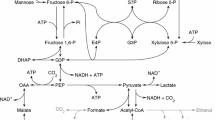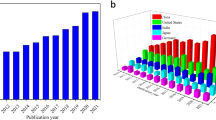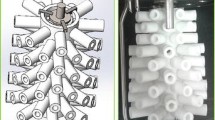Abstract
Succinic acid (SA) is a well-established chemical building block. Actinobacillus succinogenes fermentation is by far the most investigated route due to very promising high SA yield and titer on several sugars. This study contributes to include the SA production within the concept of biorefinery of lignocellulose biomass. The study was focused on the SA production by A. succinogenes DSM 22257 using sugars representative from lignocellulose hydrolysis—glucose, mannose, arabinose, and xylose—as carbon source. Single sugar batch fermentation tests and mixture sugar fermentation tests were carried out. All the sugars investigated were converted in succinic acid by A. succinogenes. The best fermentation performances were measured in tests with glucose as carbon source. The bacterial growth kinetics was characterized by glucose inhibition. No inhibition phenomena were observed with the other sugar investigated. The sugar mixture fermentation tests highlighted the synergic effects of the co-presence of the four sugars. Under the operating conditions tested, the final concentration of succinic acid in the sugar mixture test was larger (27 g/L) than that expected (25.5 g/L) by combining the fermentation of the single sugar. Moreover, the concentration of acetic and formic acid was lower, consequently obtaining an increment in the succinic acid specificity.




Similar content being viewed by others
References
Bozell, J. J., & Petersen, G. R. (2010). Technology development for the production of biobased products from biorefinery carbohydrates—the US Department of Energy’s “top 10” revisited. Green Chemistry, 12(4), 539. doi:10.1039/b922014c.
Zeikus, J. G., Jain, M. K., & Elankovan, P. (1999). Biotechnology of succinic acid production and markets for derived industrial products. Applied Microbiology and Biotechnology, 51(5), 545–552. doi:10.1007/s002530051431.
McKinlay, J. B., Vieille, C., & Zeikus, J. G. (2007). Prospects for a bio-based succinate industry. Applied Microbiology and Biotechnology, 76(4), 727–740. doi:10.1007/s00253-007-1057-y.
GrandViewResearch (2014). Bio-succinic acid market analysis by application (BDO, polyester polyols, PBS/PBST, plasticizers, alkyd resins) and segment forecasts to 2020. Retrieved from http://www.grandviewresearch.com/.
Song, H., & Lee, S. Y. (2006). Production of succinic acid by bacterial fermentation. Enzyme and Microbial Technology, 39(3), 352–361. doi:10.1016/j.enzmictec.2005.11.043.
Guettler, M. V., Rumler, D., & Jainf, M. K. (1999). Actinobacillus succinogenes sp. nov., a novel succinic-acid-producing strain from the bovine rumen. International Journal of Systematic Bacteriology, 49, 207–216.
McKinlay, J. B., Shachar-Hill, Y., Zeikus, J. G., & Vieille, C. (2007). Determining Actinobacillus succinogenes metabolic pathways and fluxes by NMR and GC-MS analyses of 13C-labeled metabolic product isotopomers. Metabolic Engineering, 9(2), 177–192. doi:10.1016/j.ymben.2006.10.006.
Wan, C., Li, Y., Shahbazi, A., & Xiu, S. (2008). Succinic acid production from cheese whey using Actinobacillus succinogenes 130 Z. Applied Biochemistry and Biotechnology, 145(1–3), 111–119. doi:10.1007/s12010-007-8031-0.
Kim, D. Y., Yim, S. C., Lee, P. C., Lee, W. G., Lee, S. Y., & Chang, H. N. (2004). Batch and continuous fermentation of succinic acid from wood hydrolysate by Mannheimia succiniciproducens MBEL55E. Enzyme and Microbial Technology, 35(6–7), 648–653. doi:10.1016/j.enzmictec.2004.08.018.
Zheng, P., Dong, J.-J., Sun, Z.-H., Ni, Y., & Fang, L. (2009). Fermentative production of succinic acid from straw hydrolysate by Actinobacillus succinogenes. Bioresource Technology, 100(8), 2425–2429. doi:10.1016/j.biortech.2008.11.043.
Cultivations of Anaerobes. Available from: http://www.www.dsmz.de. Accessed December 15, 2014
Ezeji, T. C., & Blaschek, H. P. (2008). Fermentation of dried distillers’ grains and solubles (DDGS) hydrolysates to solvents and value-added products by solventogenic clostridia. Bioresource Technology, 99(12), 5232–5242. doi:10.1016/j.biortech.2007.09.032.
Raganati, F., Götz, P., Olivieri, G., Marzocchella, A., & Salatino, P. (2015). Butanol production from hexoses and pentoses by fermentation of Clostridium acetobutylicum. Anaerobe, 34, 146–155. doi:10.3303/CET1227016.
Maharaj, K., Bradfield, M. F. A., & Nicol, W. (2014). Succinic acid-producing biofilms of Actinobacillus succinogenes: reproducibility, stability and productivity. Applied Microbiology and Biotechnology, 98(17), 7379–7386. doi:10.1007/s00253-014-5779-3.
Lin, S. K. C., Du, C., Koutinas, A., Wang, R., & Webb, C. (2008). Substrate and product inhibition kinetics in succinic acid production by Actinobacillus succinogenes. Biochemical Engineering Journal, 41(2), 128–135. doi:10.1016/j.bej.2008.03.013.
Du, C., Lin, S. K. C., Koutinas, A., Wang, R., & Webb, C. (2007). Succinic acid production from wheat using a biorefining strategy. Applied Microbiology and Biotechnology, 76(6), 1263–1270. doi:10.1007/s00253-007-1113-7.
Corona-Gonzalez, R. I., Bories, A., González-Álvarez, V., Snell-Castro, R., Toriz-González, G., & Pelayo-Ortiz, C. (2010). Succinic acid production with Actinobacillus succinogenes ZT-130 in the presence of succinic acid. Current Microbiology, 60(1), 71–77. doi:10.1007/s00284-009-9504-x.
Pateraki, C., Almqvist, H., Ladakis, D., Lidén, G., Koutinas, A. A., & Vlysidis, A. (2016). Modelling succinic acid fermentation using a xylose based substrate. Biochemical Engineering Journal, 114, 26–41. doi:10.1016/j.bej.2016.06.011.
Jiang, M., Xu, R., Xi, Y.-L., Zhang, J.-H., Dai, W.-Y., Wan, Y.-J., et al. (2013). Succinic acid production from cellobiose by Actinobacillus succinogenes. Bioresource Technology, 135, 469–474. doi:10.1016/j.biortech.2012.10.019.
Samuelov, N. S., Lamed, R., Lowe, S., & Zeikus, J. G. (1991). Influence of C02-HC03− levels and pH on growth, succinate production, and enzyme activities of Anaerobiospirillum succiniciproducens. Applied and Environmental Microbiology, 57(10), 3013–3019.
McKinlay, J. B., Laivenieks, M., Schindler, B. D., McKinlay, A. A., Siddaramappa, S., Challacombe, J. F., …, & Vieille, C. (2010). A genomic perspective on the potential of Actinobacillus succinogenes for industrial succinate production. BMC Genomics, 11(1), 680. Doi:10.1186/1471-2164-11-680.
Corona-González, R. I., Bories, A., González-Álvarez, V., & Pelayo-Ortiz, C. (2008). Kinetic study of succinic acid production by Actinobacillus succinogenes ZT-130. Process Biochemistry, 43(10), 1047–1053. doi:10.1016/j.procbio.2008.05.011.
Van der Werf, M. J., Guettler, M. V., Jain, M. K., & Zeikus, J. G. (1997). Environmental and physiological factors affecting the succinate product ratio during carbohydrate fermentation by Actinobacillus sp. 130Z. Archives of Microbiology, 167(6), 332–342 Retrieved from http://www.ncbi.nlm.nih.gov/pubmed/9148774.
Li, Q., Yang, M., Wang, D., Li, W., Wu, Y., Zhang, Y., …, & Su, Z. (2010). Efficient conversion of crop stalk wastes into succinic acid production by Actinobacillus succinogenes. Bioresource Technology, 101(9), 3292–3294. doi:10.1016/j.biortech.2009.12.064.
Acknowledgments
The study was supported by the Ministero dell’Istruzione, dell’Università e della Ricerca project “Development of green technologies for production of BIOchemicals and their use in preparation and industrial application of POLImeric materials from agricultural biomasses cultivated in a sustainable way in Campania Region—BIOPOLIS” PON03PE_00107_1/1.
Author information
Authors and Affiliations
Corresponding author
Rights and permissions
About this article
Cite this article
Ferone, M., Raganati, F., Olivieri, G. et al. Biosuccinic Acid from Lignocellulosic-Based Hexoses and Pentoses by Actinobacillus succinogenes: Characterization of the Conversion Process. Appl Biochem Biotechnol 183, 1465–1477 (2017). https://doi.org/10.1007/s12010-017-2514-4
Received:
Accepted:
Published:
Issue Date:
DOI: https://doi.org/10.1007/s12010-017-2514-4




